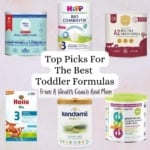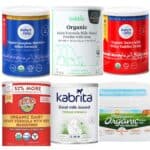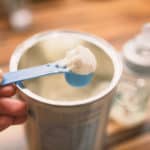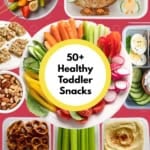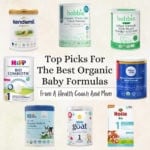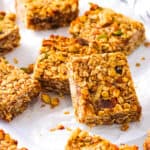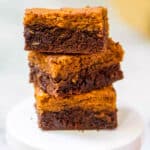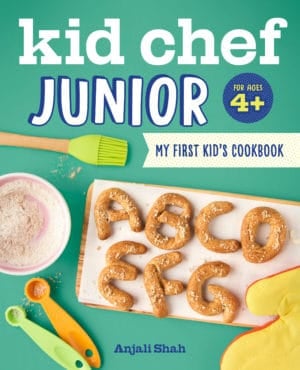How To Transition From Breastmilk To Formula
This post may contain affiliate links. As an Amazon Associate, I earn from qualifying purchases. Please read my disclosure.If you are looking into how to transition from breastmilk to formula, chances are you may be feeling a little overwhelmed, which is totally normal! That’s why I wanted to break things down to help the process go as smoothly as possible. In this guide for transitioning between breastmilk and formula, we will cover: how to introduce formula, the benefits of bottle feeding, how to choose the right bottle, how to choose the right formula, tips for getting your baby to accept a bottle, and more! Switching from breastmilk to formula doesn’t have to be stressful or daunting!
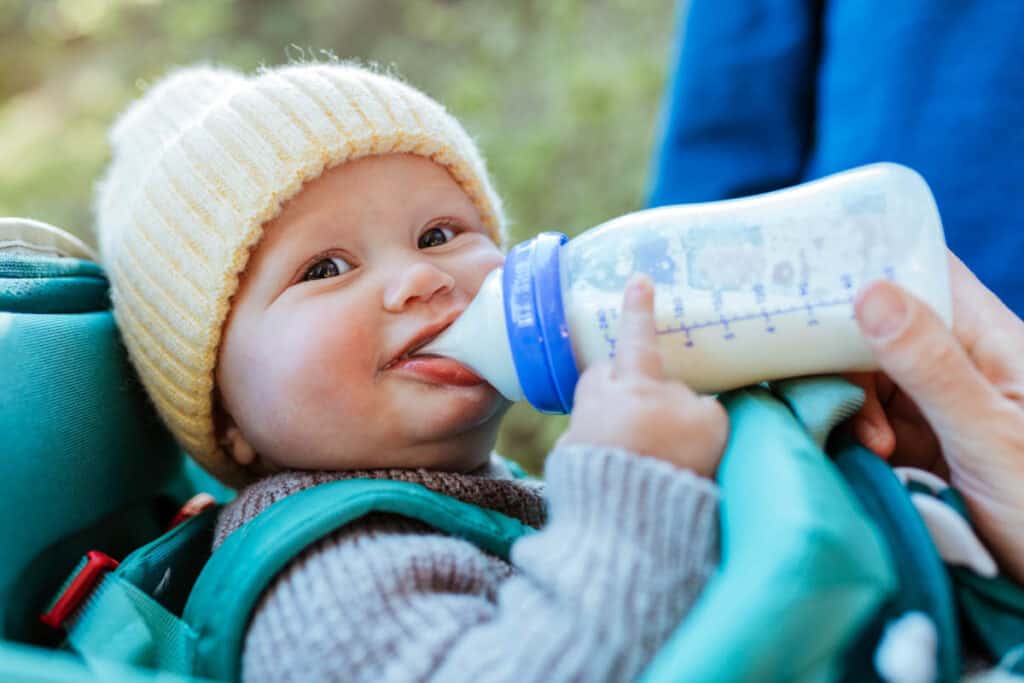
There are so many reasons as to why parents may need to transition from breastmilk to formula. While the World Health Organization recommends exclusive breastfeeding for the first 6 months, that simply may not be an option for some families for a variety of (totally valid!) reasons.
Whatever the reason may be, I know from personal experience that switching to infant formula can often come with a fear of judgment, along with a feeling of guilt. But the most important thing to remember is that every decision and choice is valid, and it is normal to have mixed emotions as a parent!
Every mom has a unique breastfeeding experience and the decision to switch to formula may be influenced by a variety of factors. Whether it be personal preference, medical conditions, shortage in supply, or the needs of the baby, the most important thing is for the baby to feel happy and nourished. FED is best! The postpartum period is already stressful and challenging enough, so if you are thinking of moving from breastfeeding to formula, a smooth transition is key.
When it comes to switching from breastmilk to formula, a gradual process is the most ideal and comfortable for both the baby and the parents. I typically recommend slowly introducing the new formula over a period of about 2 weeks, allowing the baby to adjust to a new taste, texture, and formulation.
Not only does a slow transition benefit your baby, it also helps the nursing mom! Slowly transitioning from breastmilk to formula allows the nursing mom to slowly reduce milk supply, which in turn reduces discomfort from engorgement or clogged milk ducts, and helps the body adjust to less demand for breastmilk. A gradual transition also helps with monitoring for new health changes like potential allergies and digestive issues. With love and patience, both you and your baby will have a smooth experience switching to formula!
Featured Partner Offer
Shop Bobbie Organic Infant Formula
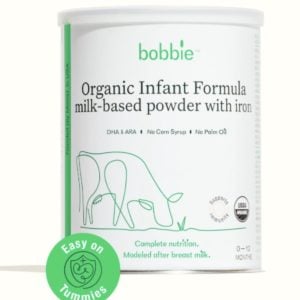
- USDA Organic, Non GMO, Clean Label Project Purity Award, Formulated with Organic Valley milk
- Easy to try with affordable starter bundle!
- EU style infant formula
- Meets all FDA requirements
- Founded and led by moms
- No corn syrup, maltodextrin, or palm oil
- Modeled after breast milk, easy on tummies
How To Introduce Formula To A Breastfed Baby
If you aren’t sure of how to transition from breastfeeding to formula feeding, you are not alone! It can be a tricky switch for babies, but following a few simple steps and methods can be very helpful.
When To Introduce Formula: When Is The Best Time To Transition To Formula?
If you are looking into how to switch from breastmilk to formula, you might be wondering when a good time is to transition. However, the right time to introduce formula to your baby’s diet will vary from family to family and based on the reason for the switch, and you can truly introduce formula whenever it feels right for you.
If you plan to primarily breastfeed, you may want to hold off on introducing formula until your little one is around 3 to 4 weeks old at least. This is because in those early weeks, frequent nursing helps you to establish a good milk supply, and helps create a good feeding pattern in the long run. Of course, if you need to supplement here and there with formula even in those early weeks, that is totally ok! But if you don’t need to supplement, I recommend waiting until 4 weeks of age to introduce formula.
After 4 weeks, again, it’s really up to you! I know lots of parents that will incorporate a bottle of formula occasionally, but will wait until later to fully transition. If you have the flexibility, it can be easiest to transition from breastmilk to formula around 6 months of age. At this age your baby is able to start trying solid foods and will be more comfortable with new flavors and tastes. Having an interest in different foods will likely make the switch to formula much easier.
Signs That Your Baby Is Ready For Formula
Unless your baby has a cow’s milk protein allergy or other digestive issues, there might not be any specific signs on when to transition from breastmilk to formula. It is really a matter of when you are ready or in need of the switch. Transitioning baby to formula can be a good idea if you have been experiencing difficulties with breastfeeding or milk supply. If your baby is already taking a bottle with breastmilk, then that is a good sign of being ready for further transition to formula. Ultimately, trust your instincts on when to switch from breastmilk to formula! You know your baby and your own body best!
How To Ensure A Smooth Transition
When it comes to transitioning from breastmilk to formula, there are a few different ways that parents might try. You can slowly wean or switch cold turkey. I personally feel the best way to ensure a smooth breastmilk to formula transition is to approach it slowly, as this is a big change for your little one. This gives your baby the opportunity to adjust and become familiar with a new taste and composition, while also allowing your body to recognize the change in demand.
To make the process even smoother, I recommend using a bottle that mimics the sensation of breastfeeding, and a formula that is most similar to breastmilk. Keeping the feeding schedule similar to your breastfeeding sessions will also help your baby feel comforted and less overwhelmed with change.
It is important to remember that every baby is different. Try to not compare your journey to anyone else’s journey during this time. The length of the transition will vary based on both the baby’s and mom’s needs and preferences. Showing your baby extra love and support during the breastmilk to formula switch can be very helpful and comforting too!
How To Wean From Breastmilk To Formula
The weaning process will look different for each baby. The most common practice for weaning from breastfeeding to formula is to start by replacing one bottle per day with formula. With gradual weaning, which means adding a small amount of formula with the breastmilk, will help your baby adjust with fewer issues. Each day you can use less breastmilk and more formula milk.
Keep reading for a sample schedule of what a 2 week transition period could look like for how to transition baby from breastmilk to formula.
How To Combo Feed Baby
If you’ve been wondering, “Can you breastfeed and formula feed?,” rest assured that you can! When it comes to breastfeeding vs. formula feeding, it doesn’t have to be just one or the other! Combination feeding is most commonly done by switching off between breastmilk and formula. You may want to start by only doing one bottle of formula each day as your baby adjusts. Once your baby is more familiar with the idea of combo feeding, you can fully incorporate it into your everyday feeding routine.
This might look like:
- Switching off between breastmilk and formula for every other feeding
- Using formula during the day and breastmilk during the night
- Breastmilk for the morning feeding and bedtime feeding, formula in between
Benefits Of Bottle Feeding
When it comes to bottle feeding, we often hear some downsides and unwarranted judgments. But the truth is, there are many benefits in switching from breastfeeding to formula or expressed milk. Some might be obvious while others may have been overlooked or never considered before. Benefits of bottle feeding include:
- Both parents can take turns with feedings
- Mom can feel more supported
- More quality baby time for other family and caregivers
- Can track if your baby is getting enough milk
- Can easily mix breastmilk with formula
- Can support healthy weight gain for baby
You may worry about missing out on that quality bonding time with your baby, but there are still plenty of ways to maintain a bond after the breastmilk transition to formula. During bottle feedings, maintain eye contact, talk or sing to your baby, and have skin to skin contact. You can form a deep bond outside of feeding times too with additional skin to skin contact, and by being present and engaged with your baby throughout the day.
How To Choose The Right Bottle For Your Baby’s Formula
Choosing the right bottle for your baby’s formula takes some time and research. It might even take a bit of trial and error to find the best fit since each baby is unique and has different preferences. Finding the right bottles is a key element in how to transition a baby from breastmilk to formula. In this section I break down the types of bottles, pros and cons, and how to choose the best bottle.
Types Of Bottles
One of the biggest differences for formula vs breastfeeding is the way in which the baby receives the milk. That’s why picking your baby’s bottle is extremely important. But it can be hard to make the right choice. There are so many different types of bottles to research and review. There are different bottle materials, different shapes, different nipples, and different flows. The most common bottles are plastic, glass, silicone, or stainless steel. As your child grows, you can change the size of the bottle and the nipple, and eventually upgrade to a toddler sippy cup or straw cups.
Pros & Cons: Plastic, Glass, Silicone, Stainless Steel Bottles
Plastic Bottles Pros & Cons
- Pros: Lightweight and easy to use, Unbreakable, Wide variety of options, Widely available, Tend to be more affordable.
- Cons: Shorter life span, Harder to clean, hand wash only, Cannot fully sanitize, have to avoid high temperatures, Chemicals like BPA and estrogenic chemicals that can seep into the milk, Can absorb odors.
Glass Bottles Pros & Cons
- Pros: Environmentally friendly, Easier to recycle, No chemicals like BPA, Easy to clean, do not stain, Durable with long lifespan, Dishwasher safe.
- Cons: Heavier, can be hard for baby to hold, More expensive up front, Breakable (but can use silicone covers), Not as many options.
Silicone Bottles Pros & Cons
- Pros: Chemical free, Lightweight and unbreakable, Easy to clean, Dishwasher safe, Very durable.
- Cons: More expensive up front, Not as many options
Stainless Steel Bottles Pros & Cons
- Pros: Chemical free, Durable and corrosion resistant, Easy to clean, Dishwasher safe, Environmentally friendly, Easier to recycle.
- Cons: More expensive up front, Not as many options, Heavier than plastic bottles (but lighter than glass).
What Are The Best Bottles For Formula?
When choosing a bottle for your baby, the material is really a personal preference. If you have an older baby that would be holding the bottle themselves, you might want to go with a lighter bottle like plastic or silicone. If you will still be holding the bottle for your little one, you can make the decision based on your budget and cleaning preferences.
Keep in mind that nipple shape matters, too! Look for a slow-flow nipple that resembles a deep latch, similar to what they have been used to with breastfeeding. This allows a baby to control the feed, pace themselves, and work for their milk.
Avoid bottles that resemble a shallow latch. The deep latch allows babies to use their mouths, facial muscles, and jaw optimally. If you are not sure which bottles to go with, the top three bottles recommended by International Board Certified Lactation Consultants are Evenflo balance +, Dr. Browns, and Lansinoh Momma.
Tips For Getting Your Baby To Accept A Bottle
Best Strategy For Bottle Introduction
If you have been wondering how to introduce a bottle to a breastfed baby, hopefully this section will be of help to you! The change from breast to bottle can be challenging for some babies, while others will accept it right away. If you experience any resistance there are a few strategies you can try out.
As already mentioned, bottle and nipple matters! In addition to that, I feel a great first step is to start with a bottle of breastmilk. This way the only change at first is the method of delivery for the breastmilk. Once the baby becomes familiar with the bottle nipple, you can then introduce the formula.
Keep reading for even more advice on how to stop breastfeeding and switch to formula bottle feeds.
How To Achieve The Right Milk Temperature
All babies are different and may prefer different temperatures, but most babies will tend to like what they are familiar with. Your baby is used to your breastmilk, which is generally lukewarm in temperature. When figuring out how to transition from breastmilk to formula, having the formula bottle prepared to the same temperature will help encourage your baby to accept the bottle.
You can achieve this temperature by placing the bottle with formula into a larger cup or bowl with warm water. Let it sit for several minutes to warm up. Test the temperature by putting a few drops on the back of your hand. If it feels lukewarm, it is ready to give to your baby! Most babies will tolerate room temperature as well, especially after a few feedings.
Common Mistakes During Bottle Feeding
If your baby is not accepting their bottle, you may be making one or two common mistakes. Bottle feeding is a learning process, just like breastfeeding! It can take time to adjust and discover the best method for both you and your baby. A few common mistakes to try avoiding include:
- Feeding your baby too frequently
- Not having the right ratio of water to formula – too little or too much formula
- Giving your baby formula that is too cold (or too hot) – you want to aim for warm milk
- Not trying enough feeding positions – sometimes it takes time to find the baby’s preferred position for taking a bottle
- Using a nipple that is too shallow or unfamiliar to baby
How To Choose The Right Formula For Your Baby
Different Types Of Formula
Choosing the right formula for your baby takes some time and research. It can feel overwhelming with all the different formulas that are available. Cow’s milk formulas alone have different categories from whole cow’s milk to lactose free, and even special formulas like A2 protein milk formulations.
Other types of formulas include goat milk formula and plant-based vegan baby formulas. In addition to this, there are US based formula brands, European brands, and Australian Brands (along with others) with organic or non-organic options. Lastly, there are formulas for each age category: Stage 1, Stage 2, and Toddler formula.
Factors To Consider When Choosing A Formula
Factors to consider when choosing a formula include:
- Food allergies & intolerances
- Budget & cost
- Organic ingredients
- US vs European vs Australian made
- Difference in formula for preemies vs. full-term babies
If your baby has a cow’s milk allergy or is lactose intolerant, choosing goat milk (learn more: Best goat milk formula) or a hypoallergenic formula would be the best option. Soy formula is also an option when no other formulas seem to work.
Tips For Choosing The Right Formula For Your Baby
When it comes to choosing the right formula, I recommend going with an organic option, or at least a non-GMO product. This ensures that your baby is getting the cleanest formula without pesticides or chemicals. In my Best Baby Formula guide I share my personal favorite brands with all the information you need to make the right choice for you!
I always recommend talking with your pediatrician or lactation consultant when choosing a formula, as they will have knowledge of your baby’s medical history.
What Formula Is Closest To Breastmilk?
If possible, it’s always great to get a baby formula closest to breastmilk, to help with baby’s digestion. By “close to breastmilk” we mean: look for a formula that has a whey:casein ratio close to that of mature breastmilk (60:40), that contains lactose (the most common carbohydrate found in breastmilk), and doesn’t contain any artificial ingredients or syrup solids.
A few brands to consider are Bobbie, Earth’s Best Organic Infant Formula, or Baby’s Only Organic Infant Formula. Enfamil NeuroPro and Similac 360 Total Care are also meant to be modeled after breastmilk, but are not organic.
If you’re looking for the best formula that is designed to be modeled after breastmilk as much as possible, I highly recommend Bobbie infant formula. That includes both the ingredients and the taste of the formula. Bobbie has a smooth, mild taste that is slightly sweet – similar to breastmilk. It also tastes much less metallic than most other formulas, which can often be the main factor in a baby’s preference for one formula over another.
Bobbie can be a great option if you’re exclusively formula feeding, or just supplementing with formula here and there because transitioning between breastmilk and Bobbie formula is typically pretty easy for babies.
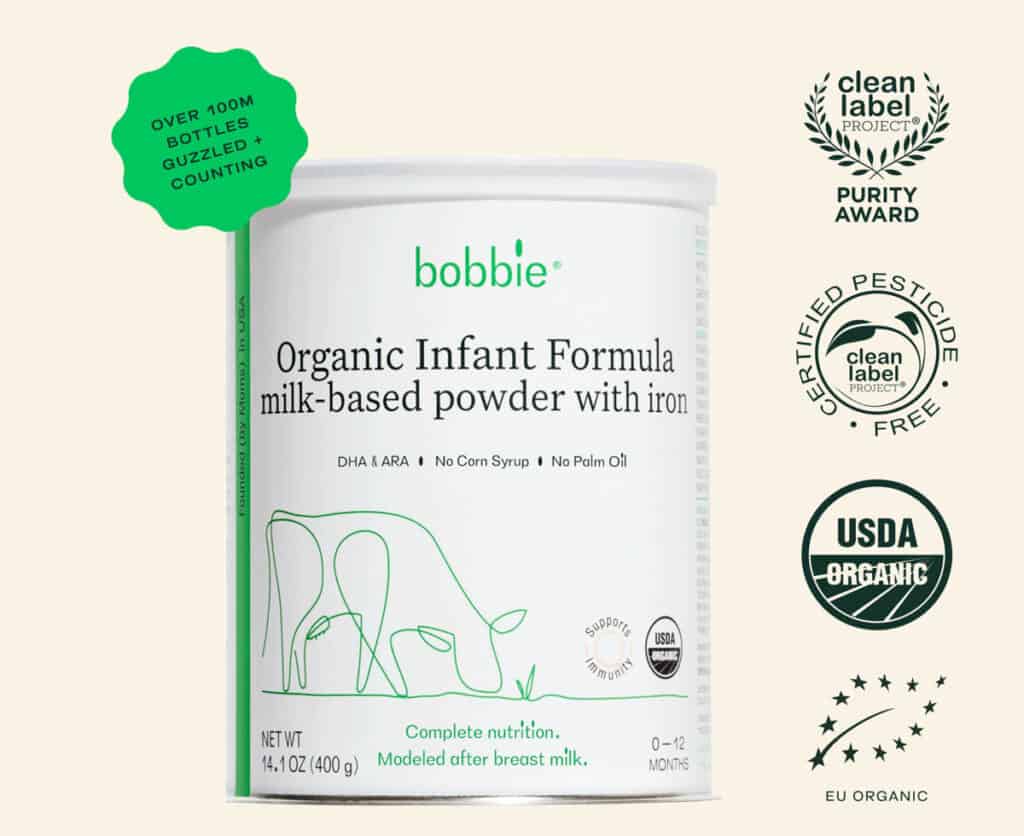
Best Formula To Supplement Breastfeeding
Supplementing while breastfeeding is really common! You might want to start weaning, or you may not have enough of a milk supply, or you may not be able to feed as regularly as you might want to. No matter why you’re choosing to supplement, the good news is that there are great options out there to choose from.
When it comes to supplementing while breastfeeding, I recommend using a formula that is nutritionally complete and tastes similar to breastmilk. I found Bobbie Infant Formula to be one of the best formulas for breastfed babies. It is a great choice for supplementing!
Bobbie is a USDA Organic and Non-GMO milk-based infant formula (for babies aged 0-12 months). It has added iron and a healthy amount of Vitamin D which is important for bone development and immune function. It is designed to support any feeding journey and all types of feeding needs.
Schedule For Transitioning To Formula
Introducing formula to a breastfed baby takes time and patience! If you aren’t sure of what type of schedule to form for transitioning to formula, you can use this sample schedule as a guide for how to mix breastmilk and formula effectively. Adjusting the breastmilk to formula ratio gradually is key. I recommend following a two week schedule to give your baby plenty of time to adjust.
- Day 1: On day 1 make one bottle with ¼ formula and ¾ breastmilk to test out how your baby reacts and responds to the change. Do this for just one of their feedings to ensure there are no allergic reactions.
- Day 2-4: For day 2-4, make each bottle with ¼ formula and ¾ breastmilk for your baby’s feedings.
- Day 5-7: For day 5-7 increase to ⅓ formula and ⅔ breastmilk for each feeding.
- Day 8-10: On days 8-10 you can add even more formula to each bottle. Try doing a half and half mixture, with ½ formula and ½ breastmilk for each feeding.
- Day 11-13: On days 11-13 you will officially have more formula than breastmilk in each bottle. Make a bottle with ¾ formula and ¼ breastmilk for each feeding.
- Day 14: On day 14 you can officially switch from breastmilk to formula. Your baby should be acclimated and comfortable with formula by now, and their digestive system should have adjusted with little problems due to the slow transition.
What Are The Side Effects From Switching Your Baby To Formula?
In general, symptoms and side effects will arise within the first 10 days of switching from breastmilk to formula. Side effects are uncommon and temporary for the most part, resolving after your baby adjusts to the change in diet.
Any time that you change formula brands, it’s a good idea to keep an eye out for reactions and changes in your baby’s behavior. If you notice any severe reaction, be sure to stop giving the formula and contact your pediatrician. Potential side effects may include:
CHANGES IN STOOL
When changing from breastmilk to formula, it is most common to have changes in stool patterns like diarrhea or minor constipation. It is a brand new diet for your little one! To aid the constipation you can try warm baths, pureed pears or prunes, or special leg movements like the bicycle pattern.
FUSSINESS
Upon transitioning to formula your baby might be more fussy than usual. This is typically normal and will resolve within a week or so. Try to provide plenty of love and comfort to your baby during this time of change.
INCREASE IN GAS
A new formula might cause an increase in gas initially. Your baby is learning how to digest something new, which can take some time to acclimate. You can do gentle stomach massages to alleviate any gassiness.
Severe side effects would include swelling of the mouth or throat, forceful vomiting, and development of hives. While these allergy symptoms are rare, it is very important to know the signs to look out for, and seek medical attention immediately.
It may be time to wean your baby off of that particular formula if side effects have not gone away within two weeks. You can consider switching formula brands and trying out a sensitive baby formula, lactose free formula, or dairy free formula depending on your baby’s needs. Goat milk formula can often be a good alternative for babies with sensitive tummies. Talk to your pediatrician about the best next steps for your family!
When your baby is 12 months of age you can officially begin weaning baby off formula and switching to a different source for those important nutrients.
FAQs For Transitioning From Breastmilk To Formula
It is best to slowly introduce formula into your breastfed baby’s routine and diet. Start by mixing a little bit of formula into their breastmilk and gradually reduce breastmilk feedings. Introduce one bottle feeding into their routine each day.
As they adjust, you can increase the amount of bottle feedings and amount of formula within each bottle. If you aren’t sure of how long to transition from breastmilk to formula, I recommend a two week period.
Formula might be considered to be slightly more filling than breastmilk due to the time it takes to be digested. When switching from breastmilk to formula you will likely notice that your baby is satiated for a longer period.
Breastmilk is more easily digested and processed in the body, so it is common to feed more frequently. If you want to keep the routine that you had with your nursing sessions when you switch to formula, you can try feeding smaller amounts in each feed.
There are about 22 calories per ounce of breastmilk. However, the exact calorie amount can change from feeding to feeding and day to day.
Some formulas could cause constipation for your baby. It depends on each brand and any intolerances or allergies your little one might have. It is also common for babies to have constipation when first making the transition to formula from breastmilk, as it is a bit harder to digest than breastmilk. Their body needs time to adjust and learn how to digest a new substance.
If you’ve been wondering, “Can I mix breastmilk with formula?” the answer is yes! Mixing formula and breastmilk is totally fine, as long as your baby tolerates both on their own. In fact, it is a great way to promote a smooth transition. You may want to start with small bottles to make sure you don’t waste any of your “liquid gold” if baby doesn’t finish the bottle. When looking for the best formula to mix with breastmilk, aim for one that is modeled after breastmilk and has no metallic taste.
Combination feeding is when a parent chooses to feed both breastmilk and formula to their baby. This might look like switching off between breastmilk and formula at feeding times or doing a combination of both in one feeding!
Please note that combination feeding can interfere with keeping up a good supply, so factor that into your decision (although you can always pump in addition to breastfeeding if you want to keep your supply up).
If your milk production is naturally low or decreasing, supplementing with a mix of formula feeding and breastmilk feeding can be very helpful. It can alleviate some of the stress you might feel and keep your baby nourished and happy.
If you are looking for the best formula to supplement breastmilk, look for one with an optimal whey:casein ratio so that it will be easiest to digest. I recommend checking out Bobbie Formula or any of the best organic formulas from my 2023 guide!
Absolutely, you can definitely still breastfeed and formula feed at night! In fact, this can be a great way for dad or other caregivers to help a breastfeeding mom out at night. Supplementing with a formula at night can allow for the other parent or caregiver to bond with the baby, while also supporting mom’s needs and promoting better sleep.
There are several signs that can indicate that the formula is causing stomach upset for your baby.
When changing from breastmilk to formula side effects may include:
** Increased fussiness, especially after eating
** Gassiness
** Vomiting
** Excessive spit up
** Abdominal pain/ looks of uncomfortableness
** Diarrhea
** Severe constipation
** Blood in baby’s stool
Please note that while these can be signs of formula intolerance, they may also be unrelated. Consult with your pediatrician for professional medical advice if you need more clarity and guidance.
Before formula, mothers might use a wet nurse if they were unable to breastfeed themselves. If parents could not afford a wet nurse they would have to try out other alternatives. This included feeding animal milk mixed with flour or grains, or evaporated milk formula with vitamin and iron supplements. Nowadays there are many healthy choices for an easy breastmilk to formula switch!
The short answer is yes, it could be. If your baby has a milk protein allergy, or if you are eating something that your baby is sensitive to, this can upset your little one’s tummy. Common foods include dairy and gluten. You can try eliminating these foods to see if that makes a difference. If you do not notice any differences or are having trouble maintaining this diet, this might be a good time to try switching from breastmilk to formula.
Going from breastmilk to formula is a big change for your little one. If your baby won’t drink infant formula, there are a few steps you can try! First off, consider trying out a new brand and look for one that is closest to natural breastmilk. Secondly, experiment with bottle and nipple size, as babies all have different preferences. You may also want to consider temperature. breastmilk is lukewarm, so try to mimic this temperature when feeding your little one.
Other things to consider:
** Try feeding when baby is truly hungry
** Try feeding baby in different positions
** Try letting someone else bottle feed baby (and you leave the room, so your baby knows that breastfeeding is not an option)
When looking at breastfeeding vs formula, the truth is that neither is better than the other – both have benefits and things to consider. In reality, a well-fed baby is the best! What is “best” just depends on both you and your baby.
There are so many factors that play a role in determining if breastmilk or formula is the best choice for your family. Formula has improved greatly over the years. You can feel comfortable and have peace of mind when switching baby from breastmilk to formula. There are many healthy, clean brands out there! Both baby formula and breastmilk include all the nutrients and vitamins your little one needs to grow strong and healthy.
If you are wondering when to stop giving baby formula, the standard rule is based on age but other factors may extend the timeframe. It is recommended to supply your baby with formula or breastmilk until 12 months of age. If you are unsure of how to switch from formula to milk, luckily it tends to be pretty easy! By this age your baby’s palate is more adaptable and open to new tastes and flavors, so weaning off formula should be no problem at all.
After your baby’s first birthday, feel free to try out cow’s milk and plant-based milk options like soy milk! As your baby gets older they typically do not need as much milk. They get calcium and protein with other dairy products and sources of food like cheese, yogurt, tofu, broccoli, chia seeds, and leafy greens.
Yes, when switching from breastmilk to formula, babies will still experience some cluster feedings as they go through growth spurts. But formula fed babies may not cluster feed in the same way as breastfed babies, because breastmilk tends to be digested faster than formula, so breastfed babies do tend to feed more often. The formulas that are more easily digested and similar to breastmilk may cause your baby to cluster feed more than some of the heavily processed formulas that sit longer in your baby’s digestive system.
More Helpful Formula Guides!
- Best Baby Formula Brands Made In the U.S.
- Best German Baby Formula
- Best Formula For Gassy Babies
- Bobbie Formula vs. Similac Formula
- Baby’s Only Vs. Earth’s Best
- Best Organic Baby Formulas
Final Thoughts
I hope you found this guide on transitioning from breastmilk to formula helpful! There is so much information out there and it can feel confusing to sort through it all, which is why I wanted to do some of that work for you, sharing my research, thoughts, and experiences.
No matter whether you exclusively breastfeed but transition to formula later, combo feed, or exclusively formula feed – you can easily move from breastmilk to formula with minimal issues! Aiming for a smooth breastmilk to formula switch helps alleviate stress during what can be a trying and unfamiliar time period.
If you have any questions about how to transition from breastmilk to formula, don’t hesitate to reach out to me via email or in the comments below! I respond to every question I get!



